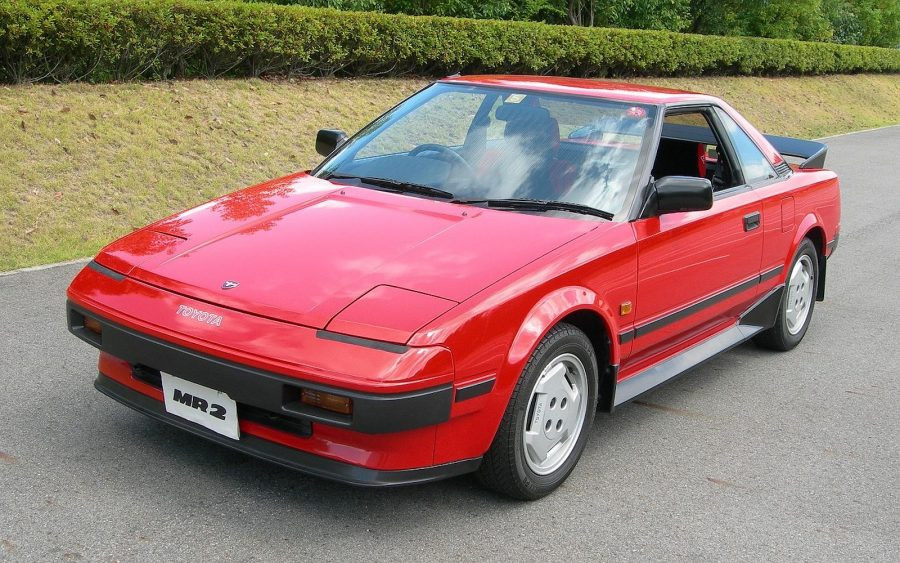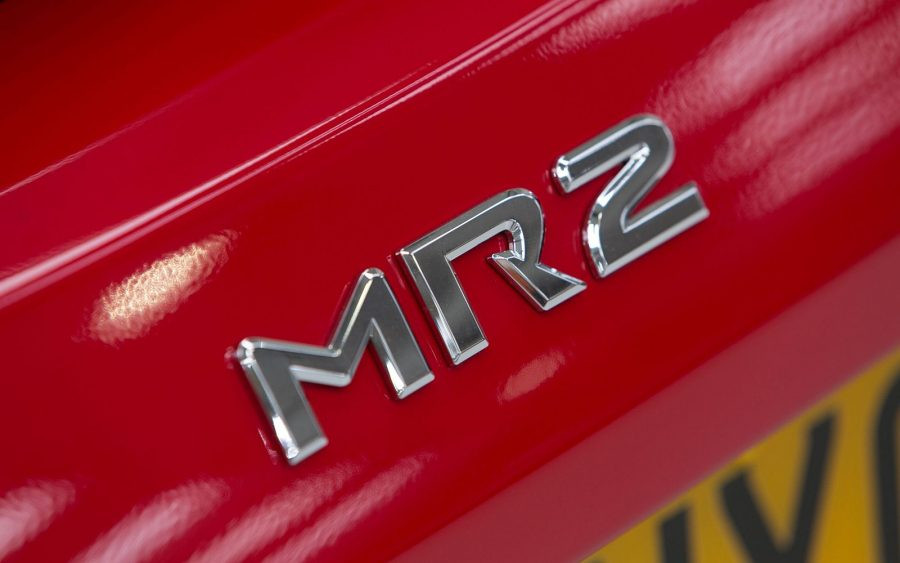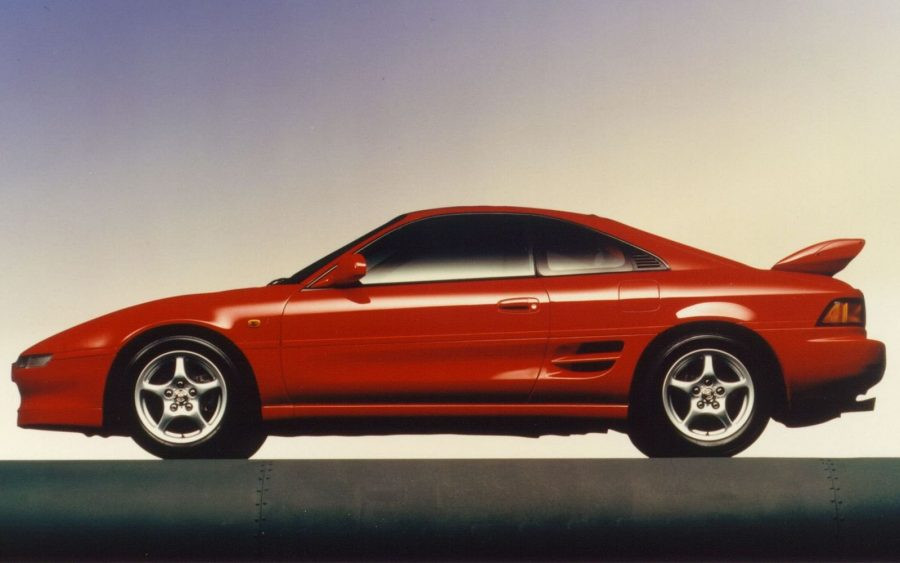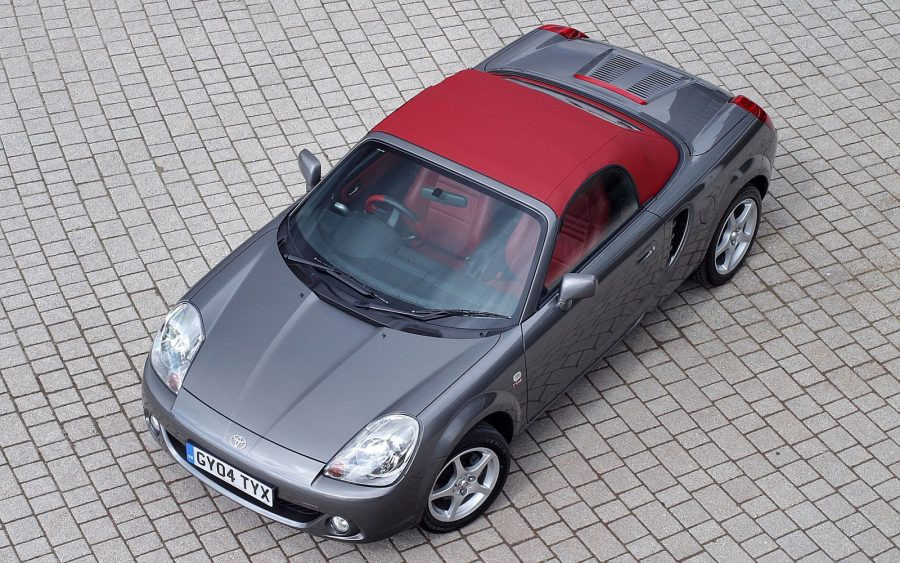Is The Toyota Mr2 Rwd? Yes, the Toyota MR2 is a rear-wheel-drive (RWD) sports car that provides a thrilling driving experience and stands out due to its mid-engine layout; check out our inventory at millertoyota.net for more details. We offer a variety of services to fulfill all of your automotive needs, including financing options and knowledgeable staff. Our service team can help you with any questions regarding maintenance.
1. What Does RWD Mean for the Toyota MR2?
RWD stands for Rear-Wheel Drive. The engine sends power to the rear wheels instead of the front wheels in a car with RWD. For the Toyota MR2, this setup offers distinct advantages:
- Enhanced Handling: RWD contributes to a balanced weight distribution, improving handling and cornering capabilities.
- Driving Experience: RWD provides a more engaging and sporty driving experience, especially appreciated by enthusiasts.
- Acceleration: RWD allows for better weight transfer during acceleration, potentially improving off-the-line performance.
The RWD configuration of the Toyota MR2 contributes significantly to its reputation as a fun and capable sports car, beloved by driving enthusiasts in Boise, Idaho, and beyond.
2. What Makes the Toyota MR2 Special?
The Toyota MR2 stands out for several reasons:
- Mid-Engine Layout: The MR2 was Japan’s first mass-produced mid-engine car. The engine is placed behind the driver but in front of the rear axle, which helps with weight distribution and handling.
- Rear-Wheel Drive (RWD): As previously mentioned, the RWD configuration adds to the sporty driving experience.
- Compact and Lightweight: The MR2 is known for its compact size and lightweight construction, which contributes to its agility and responsiveness.
- Affordable Sports Car: The MR2 offered sports car performance at an accessible price point, making it popular among enthusiasts.
- Unique Styling: Each generation of the MR2 had a unique and distinctive design, adding to its appeal.
These elements combined to make the Toyota MR2 a unique and beloved sports car, particularly among those seeking an engaging and affordable driving experience.
3. What Are the Different Generations of the Toyota MR2?
The Toyota MR2 was produced across three distinct generations, each with its unique characteristics:
- First Generation (1984-1989):
- Known as the AW11.
- Features a sharp, angular design, often referred to as a “wedge” shape.
- Powered by a 1.6-liter inline-4 engine.
- Offered a supercharged version for increased performance.
 Toyota MR2 First Generation
Toyota MR2 First Generation
Alt text: Sharp lines and wedge shape of a red first-generation Toyota MR2.
- Second Generation (1990-1999):
- Known as the SW20.
- Features a more rounded and aerodynamic design.
- Offered with a 2.0-liter inline-4 engine, naturally aspirated or turbocharged.
- Improved handling and performance compared to the first generation.
 Toyota MR2 Second Generation
Toyota MR2 Second Generation
Alt text: Sleek, black second-generation Toyota MR2 with a rounded design.
- Third Generation (2000-2007):
- Known as the W30 (or MR2 Spyder in the US).
- A roadster with a convertible top.
- Features a lightweight and minimalist design.
- Powered by a 1.8-liter inline-4 engine.
- Focused on providing a pure and engaging driving experience.
 Toyota MR2 Third Generation
Toyota MR2 Third Generation
Alt text: Silver third-generation Toyota MR2 roadster with its convertible top down.
Each generation of the Toyota MR2 offers a unique take on the mid-engine, rear-wheel-drive sports car formula.
4. What Engine Options Were Available for the Toyota MR2?
The Toyota MR2 featured several different engine options throughout its production run, depending on the generation and market:
- First Generation (AW11):
- 1.6-liter 4A-GE Inline-4: This engine was the standard option, known for its rev-happy nature and reliability. It produced around 112-128 horsepower, depending on the specific year and market.
- 1.6-liter 4A-GZE Supercharged Inline-4: This engine added a supercharger to the 4A-GE, boosting power to around 145 horsepower. This provided a significant increase in performance.
- Second Generation (SW20):
- 2.0-liter 3S-GE Inline-4: This naturally aspirated engine produced around 158-175 horsepower, depending on the year and market.
- 2.0-liter 3S-GTE Turbocharged Inline-4: This engine was the top-of-the-line option, featuring a turbocharger that boosted power to around 200-245 horsepower, depending on the year and market.
- Third Generation (W30):
- 1.8-liter 1ZZ-FE Inline-4: This engine produced around 138 horsepower. While not as powerful as some of the earlier engines, it was lightweight and contributed to the car’s nimble handling.
These engine options provided a range of performance levels for the Toyota MR2, catering to different driving preferences.
5. How Does the Mid-Engine Placement Affect the MR2’s Handling?
The mid-engine placement is a defining feature of the Toyota MR2 and has a significant impact on its handling characteristics:
- Improved Weight Distribution: Placing the engine in the middle of the car results in a more balanced weight distribution between the front and rear axles. This reduces the car’s moment of inertia, making it more responsive to steering inputs.
- Reduced Understeer and Oversteer: A balanced weight distribution helps to minimize understeer (where the front wheels lose grip and the car doesn’t turn as much as the driver intends) and oversteer (where the rear wheels lose grip and the car spins).
- Enhanced Cornering: The mid-engine layout allows for higher cornering speeds and greater stability in turns. The car feels more planted and predictable, inspiring confidence in the driver.
- Increased Agility: The reduced moment of inertia makes the car feel more agile and nimble. It changes direction quickly and easily, making it a joy to drive on winding roads.
Overall, the mid-engine placement of the Toyota MR2 contributes to a more engaging, responsive, and balanced driving experience.
6. What Are Some Common Problems or Issues with the Toyota MR2?
Like any car, the Toyota MR2 has some common problems or issues that owners should be aware of:
- First Generation (AW11):
- Rust: The AW11 is prone to rust, especially in areas with harsh winters or salty roads.
- T-Tops Leaks: Models with T-tops can experience leaks, especially as the seals age.
- Supercharger Issues (4A-GZE): The supercharger on the 4A-GZE engine can require maintenance and may be prone to failure over time.
- Second Generation (SW20):
- Snap Oversteer: Early SW20 models were known for their tendency to snap oversteer, especially in inexperienced hands. Toyota made suspension revisions to address this issue.
- Turbocharger Problems (3S-GTE): The turbocharger on the 3S-GTE engine can be prone to failure if not properly maintained.
- Oil Leaks: The 3S-GE and 3S-GTE engines can develop oil leaks over time.
- Third Generation (W30):
- Pre-cat Failure: The catalytic converters in the exhaust manifold can fail and send debris back into the engine, causing damage.
- Oil Consumption: The 1ZZ-FE engine is known for its tendency to consume oil, especially at higher mileage.
- Soft Top Issues: The convertible top can be prone to wear and tear, and may require replacement over time.
It’s essential to have any used Toyota MR2 inspected by a qualified mechanic before purchasing to identify any potential issues.
7. How Does the Toyota MR2 Compare to Other Sports Cars of Its Time?
The Toyota MR2 competed with several other sports cars during its production run. Here’s a comparison to some of its rivals:
| Feature | Toyota MR2 | Mazda MX-5 Miata | Honda CRX | Pontiac Fiero |
|---|---|---|---|---|
| Layout | Mid-engine, RWD | Front-engine, RWD | Front-engine, FWD | Mid-engine, RWD |
| Handling | Excellent, balanced, and responsive | Agile, nimble, and fun | Sporty, but with FWD characteristics | Unique, but can be prone to handling quirks |
| Performance | Good, especially with the turbocharged engine | Adequate, but not as powerful as some rivals | Good for its size and weight | Decent, but often criticized for lack of power |
| Price | Affordable | Affordable | Affordable | Affordable |
| Unique Features | Mid-engine layout, distinctive styling | Convertible top, classic roadster experience | Lightweight, fuel-efficient, sporty hatchback | Mid-engine layout, unique styling |
| Common Issues | Rust, T-top leaks (AW11), snap oversteer (SW20), oil consumption (W30) | Rust, soft-top wear, valve guide issues | Rust, rear suspension issues | Engine problems, electrical issues, suspension problems |
| Target Audience | Enthusiasts seeking a unique, mid-engine sports car at an affordable price | Enthusiasts seeking a classic roadster experience with a focus on handling | Drivers seeking a sporty and fuel-efficient compact car | Drivers seeking a unique, American-made mid-engine sports car at a low price |
The Toyota MR2 offered a unique combination of mid-engine layout, rear-wheel drive, and affordability that set it apart from many of its competitors.
8. Is the Toyota MR2 a Good Car for Daily Driving?
Whether the Toyota MR2 is a good car for daily driving depends on individual needs and preferences:
- Pros:
- Compact Size: The MR2’s small size makes it easy to maneuver and park in urban environments.
- Fuel Efficiency: The MR2 can be reasonably fuel-efficient, especially the third-generation model.
- Fun to Drive: The MR2’s engaging handling and sporty character can make daily commutes more enjoyable.
- Cons:
- Limited Cargo Space: The MR2 has very limited cargo space, making it impractical for hauling large items.
- Ride Comfort: The MR2’s sporty suspension can result in a firm ride, which may not be comfortable for long trips.
- Noise: The MR2 can be noisy, especially at highway speeds.
- Two-Seater: The MR2 only has two seats, making it unsuitable for families or those who frequently need to carry passengers.
Overall, the Toyota MR2 can be a fun and engaging daily driver for individuals who prioritize sporty handling and compact size over practicality and comfort.
9. What Kind of Aftermarket Support Is Available for the Toyota MR2?
The Toyota MR2 has a strong aftermarket following, with a wide range of parts and accessories available to improve its performance, handling, and appearance.
- Performance Parts:
- Engine upgrades (turbo kits, supercharger kits, camshafts, etc.)
- Exhaust systems
- Intake systems
- ECU tuning
- Handling Parts:
- Suspension upgrades (coilovers, springs, sway bars, etc.)
- Brake upgrades (rotors, calipers, pads, etc.)
- Wheels and tires
- Appearance Parts:
- Body kits
- Spoilers
- Interior trim
- Lighting upgrades
There are numerous online retailers and specialty shops that cater to the Toyota MR2 aftermarket.
10. Where Can I Find a Toyota MR2 for Sale in the Boise Area?
If you’re looking to find a Toyota MR2 for sale in the Boise area, here are some options:
- Online Marketplaces:
- Websites like Craigslist, Facebook Marketplace, and AutoTrader often have listings for used Toyota MR2s.
- Be sure to thoroughly inspect any vehicle before purchasing and have it checked out by a qualified mechanic.
- Online Auction Sites:
- Websites like Bring a Trailer and Cars & Bids specialize in auctioning off collectible cars, including the Toyota MR2.
- Classic Car Dealers:
- Some classic car dealers may have Toyota MR2s in their inventory.
- Local Car Clubs and Enthusiast Groups:
- Networking with local car clubs and enthusiast groups can be a great way to find a Toyota MR2 for sale.
When searching for a Toyota MR2, it’s essential to do your research, inspect the car carefully, and have it checked out by a mechanic to ensure you’re getting a good value.
11. What are the Performance Specs of the Toyota MR2?
The performance specs of the Toyota MR2 varied depending on the generation and engine option:
| 1st Gen (AW11) 1.6L | 1st Gen (AW11) Supercharged 1.6L | 2nd Gen (SW20) 2.0L | 2nd Gen (SW20) Turbo 2.0L | 3rd Gen (W30) 1.8L | |
|---|---|---|---|---|---|
| Horsepower | 112-128 hp | 145 hp | 158-175 hp | 200-245 hp | 138 hp |
| Torque | 97-105 lb-ft | 137 lb-ft | 140-148 lb-ft | 200-220 lb-ft | 125 lb-ft |
| 0-60 mph | 8-9 seconds | 7-8 seconds | 6-7 seconds | 5-6 seconds | 6.8-7.0 seconds |
| Top Speed | 120-130 mph | 130-140 mph | 135-145 mph | 150-160 mph | 135 mph |
| Weight | 2,350-2,500 lbs | 2,450-2,600 lbs | 2,700-2,900 lbs | 2,800-3,000 lbs | 2,200-2,400 lbs |
| Layout | Mid-engine, RWD | Mid-engine, RWD | Mid-engine, RWD | Mid-engine, RWD | Mid-engine, RWD |
| Transmission | 5-speed manual | 5-speed manual | 5-speed manual | 5-speed manual | 5-speed manual/SMT |
These specs showcase the Toyota MR2’s evolution over the years, with each generation offering a unique blend of performance and driving experience.
12. What is the Interior Like in a Toyota MR2?
The interior of the Toyota MR2 varied depending on the generation, but here are some common characteristics:
- First Generation (AW11):
- Simple and functional design.
- Basic features like air conditioning, power windows, and a stereo system.
- Sport seats with good bolstering.
 Toyota MR2 First Generation Interior
Toyota MR2 First Generation Interior
Alt text: Interior view of a classic Toyota MR2, showing its simple dashboard and sporty seats.
- Second Generation (SW20):
- More refined and modern design.
- Improved materials and features.
- Available with options like leather seats, sunroof, and upgraded audio systems.
- Third Generation (W30):
- Minimalist and driver-focused design.
- Basic features to keep the weight down.
- Sport seats with good support.
The Toyota MR2’s interior was generally focused on functionality and providing a sporty driving experience.
13. How Many Toyota MR2s Were Made?
Here’s an approximate breakdown of the production numbers for each generation of the Toyota MR2:
- First Generation (AW11): Approximately 163,000 units were produced from 1984 to 1989.
- Second Generation (SW20): Approximately 82,000 units were produced from 1990 to 1999.
- Third Generation (W30): Approximately 75,000 units were produced from 2000 to 2007.
These production numbers highlight the Toyota MR2’s popularity and enduring appeal.
14. What Special Editions of the Toyota MR2 Were Available?
Throughout its production run, Toyota released several special editions of the MR2, including:
- Toyota Technocraft Spider (SW20): An open-top conversion of the second-generation MR2, produced in limited numbers.
- TRD 2000GT (SW20): A wide-bodied version of the second-generation MR2, inspired by the Toyota TRD 2000GT race car.
- Red Collection (W30): A special edition of the third-generation MR2 with a unique red and black color scheme.
 Toyota MR2 Red Collection
Toyota MR2 Red Collection
Alt text: Graphite grey Red Collection Toyota MR2 with contrasting red leather interior.
- TF300 (W30): The final 300 examples of the third-generation MR2, each built to order with a dedicated vehicle number.
These special editions added unique styling and features to the Toyota MR2, making them highly sought after by collectors and enthusiasts.
15. What Kind of Maintenance is Required for a Toyota MR2?
The maintenance required for a Toyota MR2 is similar to most other cars, but here are some specific considerations:
- Regular Oil Changes: Regular oil changes are crucial to keep the engine running smoothly and prevent wear.
- Timing Belt Replacement (if applicable): Some MR2 engines (like the 4A-GE) have a timing belt that needs to be replaced at regular intervals to prevent catastrophic engine damage.
- Coolant Flushes: Regular coolant flushes help to prevent corrosion and maintain proper engine temperature.
- Spark Plug Replacement: Replacing the spark plugs at the recommended intervals ensures proper ignition and engine performance.
- Brake Service: Regular brake inspections and service are essential to ensure safe stopping performance.
- Suspension Maintenance: The MR2’s suspension components may need to be replaced over time, especially if the car is driven hard.
Following the manufacturer’s recommended maintenance schedule and addressing any issues promptly will help to keep your Toyota MR2 running smoothly for years to come.
16. Is the Toyota MR2 Safe?
The safety of the Toyota MR2 varied depending on the generation and the safety standards of the time:
- First Generation (AW11):
- Basic safety features like seatbelts and a reinforced chassis.
- No airbags or advanced safety systems.
- Second Generation (SW20):
- Improved chassis design.
- Available with driver-side airbags in some markets.
- Third Generation (W30):
- Lightweight design may compromise crash protection.
- Available with driver and passenger airbags in some markets.
Overall, the Toyota MR2 was not designed with the same level of safety as modern cars.
17. Can You Modify a Toyota MR2?
Yes, the Toyota MR2 is a popular platform for modification. Here are common modifications:
- Engine Swaps: Many owners swap in more powerful engines, such as the Honda K20 or Toyota 2GR-FE.
- Turbocharger Upgrades: Owners often upgrade the turbocharger to increase horsepower.
- Suspension Upgrades: Upgrading the suspension can improve handling and cornering.
- Brake Upgrades: Upgrading the brakes can improve stopping power.
- Aesthetic Modifications: Owners often add body kits, spoilers, and custom paint jobs.
Modifying a Toyota MR2 can be a great way to personalize the car and improve its performance, but it’s essential to do your research and choose quality parts to ensure reliability.
18. What is the Resale Value of a Toyota MR2?
The resale value of a Toyota MR2 varies depending on the generation, condition, mileage, and location:
- First Generation (AW11): Well-preserved examples can fetch between $10,000 and $20,000.
- Second Generation (SW20): Prices range from $15,000 to $30,000, depending on condition and whether it’s a turbocharged model.
- Third Generation (W30): Prices typically range from $10,000 to $20,000.
Overall, the Toyota MR2 has held its value well over the years.
19. Does the Toyota MR2 Have a Targa Top?
Yes, some models of the Toyota MR2 came with a T-top roof. The T-top roof features two removable glass panels that allow for an open-air driving experience while maintaining some of the structural rigidity of a coupe.
 Toyota MR2 T-Top
Toyota MR2 T-Top
Alt text: Toyota MR2 with T-top roof removed, showcasing its open-air design.
20. What is the Toyota MR2 SMT Transmission?
The Toyota MR2 SMT transmission is a sequential manual transmission offered on the third-generation (W30) model.
Key features of the SMT transmission:
- Automated Manual: The SMT is a manual transmission with an automated clutch and gear shifting system.
- No Clutch Pedal: The driver does not need to use a clutch pedal.
- Sequential Shifting: The driver shifts gears sequentially using paddles or a gear lever.
- Automatic Mode: The SMT can also be operated in a fully automatic mode.
The SMT transmission offered a unique driving experience, combining the control of a manual transmission with the convenience of an automatic.
21. What Are the Pros and Cons of Owning a Toyota MR2?
Here’s a summary of the pros and cons of owning a Toyota MR2:
| Pros | Cons |
|---|---|
| Unique mid-engine layout | Limited cargo space |
| Fun and engaging handling | Can be noisy |
| Affordable sports car | Only two seats |
| Strong aftermarket support | Firm ride |
| Holds its value well | Requires regular maintenance |
| Available in multiple generations | Safety features are outdated |
22. Is a Toyota MR2 a Good Investment?
Whether a Toyota MR2 is a good investment depends on your goals and expectations. If you’re looking for a car that will appreciate significantly in value, it may not be the best choice. However, if you’re looking for a fun and engaging sports car that you can enjoy driving, the Toyota MR2 can be a great investment.
FAQ About The Toyota MR2 RWD
- Is the Toyota MR2 fun to drive?
- Yes, the Toyota MR2 is known for its fun and engaging driving experience. Its mid-engine layout, rear-wheel drive, and lightweight construction contribute to its nimble handling and responsive performance.
- Is the Toyota MR2 reliable?
- Yes, the Toyota MR2 is generally considered to be a reliable car, especially when properly maintained.
- Is the Toyota MR2 a good first car?
- The Toyota MR2 may not be the best choice as a first car for inexperienced drivers. Its sporty handling and rear-wheel drive can be challenging to control, especially in wet or slippery conditions.
- Is the Toyota MR2 easy to work on?
- The Toyota MR2 can be relatively easy to work on, but some tasks can be more challenging due to the mid-engine layout.
- Is the Toyota MR2 a good track car?
- Yes, the Toyota MR2 can be a great track car. Its balanced handling, responsive performance, and strong aftermarket support make it a popular choice for track days and racing.
- Is the Toyota MR2 expensive to insure?
- The cost of insuring a Toyota MR2 can vary depending on your age, driving record, location, and the specific insurance company.
- Is the Toyota MR2 comfortable for long trips?
- The Toyota MR2 may not be the most comfortable car for long trips. Its sporty suspension can result in a firm ride, and the cabin can be noisy.
- Is the Toyota MR2 a good car for winter driving?
- The Toyota MR2 may not be the best choice for winter driving. Its rear-wheel drive can make it challenging to control in snow or ice.
- Is the Toyota MR2 a collectible car?
- Yes, the Toyota MR2 is becoming increasingly collectible, especially well-preserved examples of the first and second generations.
- Is the Toyota MR2 still in production?
- No, the Toyota MR2 is no longer in production. The last model was sold in 2007.
Considering a Toyota MR2? Visit millertoyota.net today to explore your options, schedule a service, or learn more about this iconic sports car. Contact us at +1 (208) 376-8888 or visit our location at 208 N Maple Grove Rd, Boise, ID 83704, United States. Find your dream car and experience the thrill of driving a Toyota!